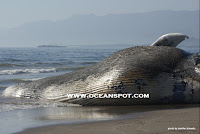If so, please make sure to download the 2009 Sustainable Seafood Guide for Sushi. Just click the link or the image below and print out the PDF which you can then fold into a wallet card.
 Did you know that our love for sushi is severely depleting many of our oceans' fishes? Bluefin tuna are in particular danger because they have been so drastically overfished. A more responsible alternative to bluefin tuna is albacore tuna (shiro maguro).
Did you know that our love for sushi is severely depleting many of our oceans' fishes? Bluefin tuna are in particular danger because they have been so drastically overfished. A more responsible alternative to bluefin tuna is albacore tuna (shiro maguro).In addition to downloading your handy sustainable sushi pocket guide, also be sure to download the 2009 Seafood Watch guide for your local region, as well. We all need to take care of our oceans. Whether dining in or out, be sure to express an interest in sustainable seafood options to your grocer, chef, or restaurant. As long as they know there's consumer demand for sustainable options, they hopefully will make responsible choices about what types of seafood to supply.
And remember . . . never order the Chilean Seabass! This fish has been severly overfished to the point where there is a great deal of illegal fishing taking place. Did you know that the real name of the Chilean Seabass is the "Patagonian Toothfish"? The name was changed for marketing purposes so that it would sound more appetizing to consumers. Let's leave the toothfish alone for a while and try to let them recover. . .














































